Machine learning, data analytics and responsive user interfaces have changed enterprise expectations for business applications. At the same time, microservices, cloud computing and DevOps have transformed the way these business applications can be developed.
Using iterative development, the Accion Breeze blueprint values user experience nearly above all else. Zephyr and Alizeh are at the foundation of the Breeze blueprint. The two interfaces combined provide unique a UI designed to change the way users design and interact with business applications. When taken together, Zephyr and Alizeh consist of automation and search agents, collaboration and business tools, customized events, conversation widgets and more.
In this resource we take a deep dive into how Zephyr and Alizeh work together for a transformative UI in business applications. We will be looking at:
- The drivers of change that led to the creation of Accion Breeze, including the Zephyr and Alizeh interfaces.
- The underlying concept of Accion Breeze, and how the two product interfaces support the concept.
- The product components and product map of Zephyr and Alizeh.
- The specific components of the product interfaces as personalized, self learning and conversational.
- The design process for Zephyr and Alizeh.
- The UI design of Zephyr and Alizeh, including visualizations as conversational, web based and mobile interfaces.
- The architectural blueprint for Zephyr and Alizeh with a microservices approach to development.
Accion Breeze: The Drivers behind the blueprint
The blueprint for Accion Breeze was motivated by the lessons we have learned in working with clients in digital transformation.
The goal of Accion Breeze is to stay ahead of the curve with microservices, cloud computing and responsive user interfaces. Before jumping into how Accion Breeze is built, we can first look at the drivers that led to a brand new blueprint for business application development.
These are a few of the transformational drivers that led to the creation of the Accion reeze blueprint:
The Drive to Transform User Experience: Conversational interfaces and proactive recommendations are becoming the new norm for UX. The Drive to Build a Digital Domain: AI driven knowledge bases and automation create the opportunity for robust and quickly released business tools. The Drive to Increase Engagement: Market, customer and employee engagement have become the core of business success today. Accion Breeze works to increase this engagement.
Technology Drivers at the Core of Accion Breeze:
At the core of the Breeze blueprint are the business environment drivers described above. These drivers describe the purpose behind Breeze as a new framework for business applications. On top of these drivers, we recognized a range of developments in technology that opened the opportunity to change the paradigm of business application development. These are the technology drivers that give power to the various components of Breeze:
- AI & Machine Learning
- Data Lake & Big Data Analytics
- Natural Language Processing (NLP)
- Robotic Process Automation
- Responsive User Interfaces
- Voice Interface & Chat Bots
- Cloud Computing, Containers & Serverless Computing
- Microservices
- User Generated Content & Social Media
- DevOps
Accion Zephyr: A Blueprint for the Conversational UI
Zephyr provides the components necessary to implement conversational interfaces. The interface supports a range of devices and cloud platforms, with ready to use conversational widgets and automation agents designed to implement varied conversations across a wide range of users.

As an interface, Zephyr provides a product blueprint for developing targeted business applications. This includes templates for conversational widgets, automation agents, automated testing frameworks and deployment automation scripts.
As you can see in the graphic above, Zephyr is broken down into four elements as a conversational user interface:
Smart Search uses natural language queries and an AI based search to find the most relevant results for users. Zephyr searches globally through all data, including editorial content, user generated content, people profiles, and more. The query returns faceted search results, with smart recommendations based on related content.
Actionable Notifications add Action Widgets to alerts and reminders. This allows users to take immediate action, especially with high priority or urgent notifications. Based on data, the priority of these notifications increase or decrease along with a delay in user response. Unattended notifications are automatically escalated.
Automation Agents allow automatic actions taken on a user’s behalf, with minimal manual intervention. These actions are predefined based on frequently used actions - form filling, email and text, blog creation, and uploads are all included in the agent. Agent configuration is simplified with an if/then approach.
Recommendation Engine tracks context and content of all user actions. Location, date and time, and type of data entered are all tracked. The pattern is then used to recommend features based on user preferences. As a conversational UI, Zephyr can be broken down into three components:
User Experience Design: At the frontend of the interface for users.
Conversation Widgets: The basis of the frontend UI, call response based on dialog and action handlers.
Action Agents: Work as microservices for notifications, automation, business services, search, and custom events.
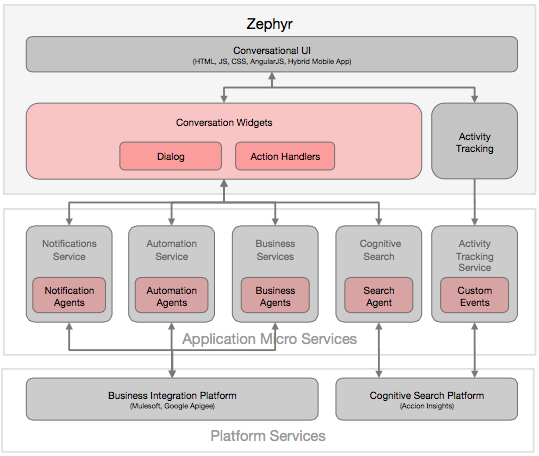
Zephyr provides a conversational UI for users. With a microservices approach, the UI uses agents to communicate between databases, platforms and services.
On the whole, Zephyr provides components for implementation of conversational interfaces that support a range of devices and cloud platforms. The framework includes the agents described above to implement conversations across all user types. The result is a highly customized user experience within any business application using the framework:
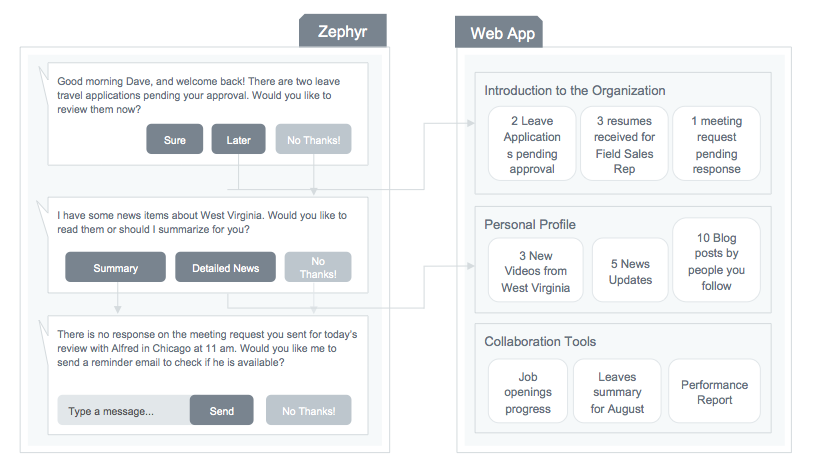
The Zephyr framework takes an iterative approach to business application development. Developers are walked through sprints from the backlog and design stages to testing and analytics stages.
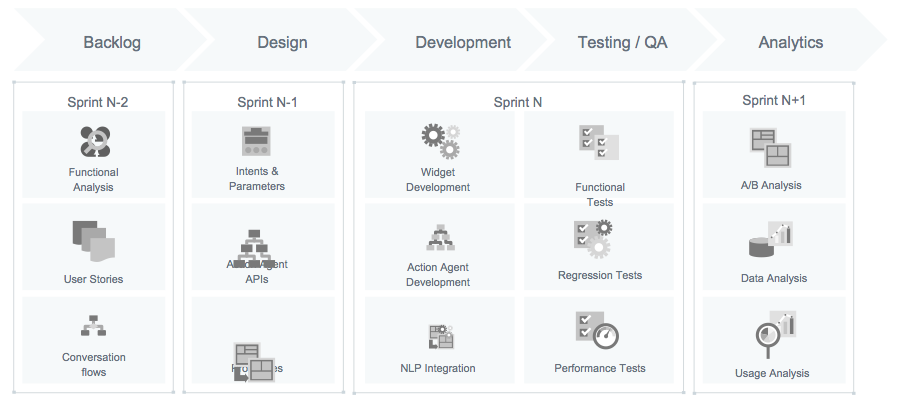
The iterative approach breaks the development process down into specific projects that even small DevOps teams can complete in a timely manner. From user stories to functional and performance tests, these projects are time-bound by the sprints and meant to be completed before moving forward with development. For the Zephyr framework, this translates into a business application that can be deployed quickly.
Accion Alizeh: A Blueprint for the web based UI
Alizeh provides users a web based interface to access the business product. It is a highly personalized, self learning web interface.

As the graphic above shows, Alizeh is broken down into four key elements as a web based interface:
- Content Services: Alizeh creates a content repository that is categorized and enhanced with appropriate metadata. The data includes people and organizational information (company profiles and user profiles, as well as user generated content such as photo albums, videos, blogs comments, and social interactions.
- Collaboration Services: The Alizeh framework creates tools for collaboration between multiple users (such as workflows). The interface allows interpersonal communication using a combination of synchronous and asynchronous modes. It can also be used for collaborative content creation tools, such as discussion forums and wikis.
- Business Services: The web based interface integrates with backend business applications. This access unifies the user interface for all business functions that are supported by various business applications. Alizeh creates a seamless interface for these business applications.
- Recommendation Engine: The recommendation engine uses the same framework as that of Zephyr. Tracking context and usage pattern creates customized recommendations for each individual user.
These four elements combine to create a web UI for users to look up information, collaborate with others and to perform various business tasks.
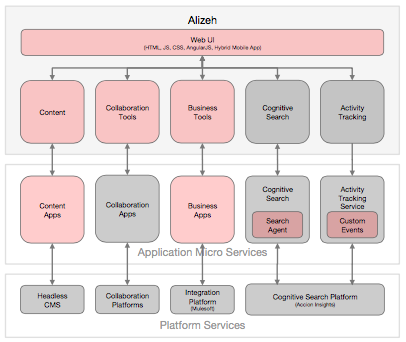
As you can see in the architectural blueprint for Alizeh, the interface is based on a microservices development model. Users see a unified web UI, with all Breeze systems running as microservices in the background. Content functions connect to headless CMS with content apps, collaboration tools connect to collaboration platforms using specific apps, and business tools connect with an integration platform for external business applications. Cognitive Search and Activity Tracking are common across the entire application, and dependent on their own agents and cognitive search platform.
The product catalog of Alizeh include these main components:
User Login: Provides features providing mechanisms for users to sign up or login if already signed up. Content Objects: Provide a Self Service Portal with support for two types of content objects: Static Content and Articles. Static Content is not time sensitive, such as business information, services, and policies. Articles are time sensitive content relevant for a specific time period, such as news, blogs, or business updates. The metadata for these objects can be customized. Collaboration Tools: Provide users a mechanism to interact with each other. Customized tools can be built based on the nature of collaboration required. Business Tools: Provide customers access to various business tools that can integrate with backend business applications and provide a unified user experience to users. UX Design: Designed specifically to address various user persona and workflows required for the product.
The Breeze Architectural Blueprint: Combining Zephyr & Alizeh
While the UI of Zephyr & Alizeh are the focus of this resource, at the foundation of these interfaces are the application microservices and platform services in the architectural blueprint.
- Application Microservices: Provide backend APIs to all the frontend components. They are exposed through an API Gateway. This also allows modules to be agnostic of platform services.
- Platform Services: Shared platforms that support all the Application Microservices. Some of the platform services are used only for individual applications while others are shared by all applications.
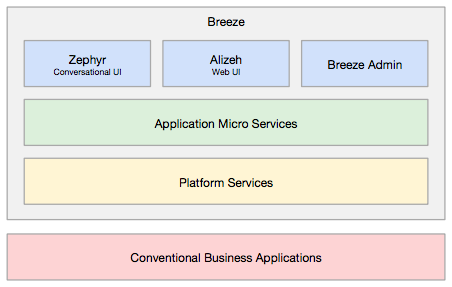
The combination of Zephyr and Alizeh with these foundational elements make up the entirety of the Breeze framework for business applications. Breeze Admin is used as a go between for the frontend and backend elements of the blueprint.
Combining Alizeh & Zephyr for web based and mobile based interfaces
Since Alizeh and Zephyr are designed for a better user experience in business applications, the two interfaces can be combined on both web and mobile platforms. The combination customizes the business application while maintaining the conversational nature of Zephyr and the content strength of Alizeh.
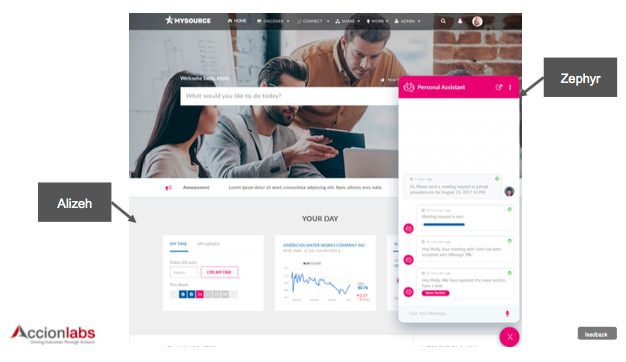
Integration with backend business applications
Breeze can be used to create targeted business applications or interdepartmental enterprise solutions for organization-wide processes.
Backend business applications are external to Breeze and provide various backend business functions. The list included here is for illustration of the many types of applications that can be integrated with applications using the Breeze blueprint. The actual applications integrated will be finalized after the blueprint alignment stage of the product design process. Some examples are:
- HR Tools - This includes log tracers, salary slips, etc.
- Finance Tools - This includes tracking expenses, collections, etc.
- Sales marketing Tools - This includes Customer Relationship Management, Lead Generation, etc.
- Procurement - This includes requisition, maintenance, etc.
- Customer Support Tools - This includes support tickets, social support, etc.
- Jobs & Recruitment - This includes Job listings, resume tracking, on boarding, etc.
- E-Learning/Training - This includes structured Courses, testing and evaluation, etc.
- Communications - This includes email tools, calendar collaboration, contracts, collaboration tools, etc.
Zephyr Implementation Success Stories
An understanding of how Zephyr and Alizeh approach business applications is not complete without covering what the UI frameworks look like in practice. Zephyr fits a wide range of business processes, across company sizes and industries. Accion has implemented Breeze framework across a range of industries. Some of the projects implemented using Zephyr include:
- UVA Mobile uses Zephyr to create easy customization of service using voice, text and visual UI.
- Healthcare App uses Zephyr to connect cancer patients to family and healthcare providers with a mobile app and a HIPAA compliant social network.
- TripChamp uses Zephyr to personalize travel and accommodation recommendations. The personalization is based on GDS data and unstructured data from social media, websites and customer feedback conversations. The result is a predictive, personalized web interface with natural language queries.
The Zephyr and Alizeh can be used across business processes, bringing microservices and AI technology into day-to-day operations. Contact us for more information about using the Accion Breeze framework!
